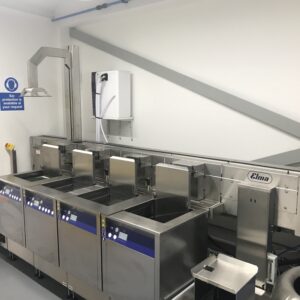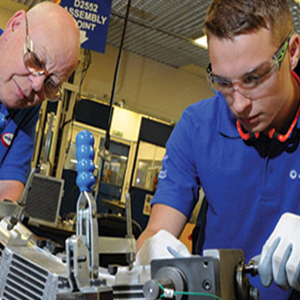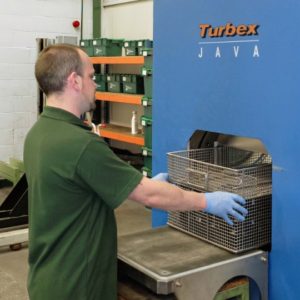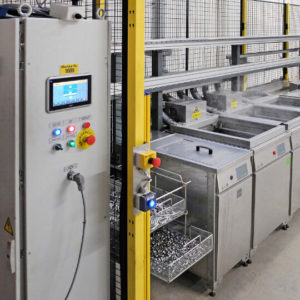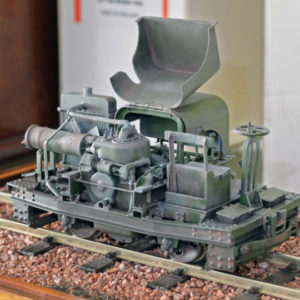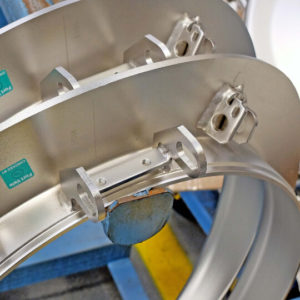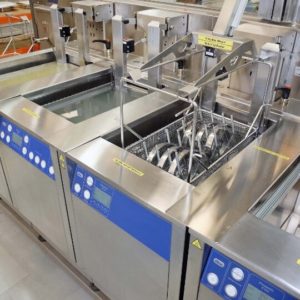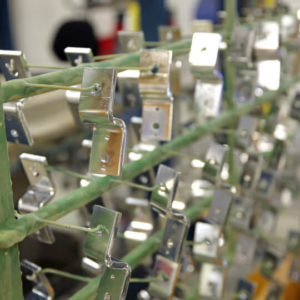From the smallest details to the highest pursuits, Collins Aerospace is dedicated to redefining aerospace. They pride themselves on tackling the toughest challenges in the industry and believe in the power of intelligence and partnership to guide their customers into the future.
Having spent over ten years working with Collins providing them with degreasing and cleaning solutions for their manufacture, we sat down with Philip Bucknall, Senior Manufacturing Engineer to reflect on how the business relationship came about and why they chose to work with Simon Graham, now of Turbex.
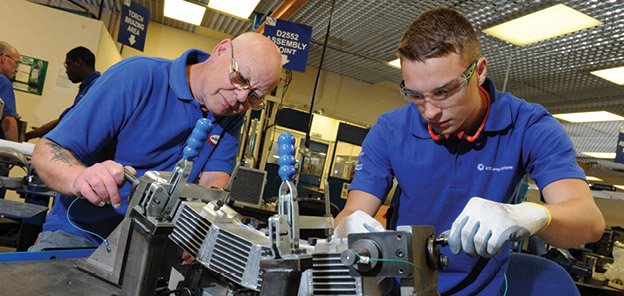
How did the relationship begin with Simon?
As part of the initial manufacturing process, we have to clean components, and given the processes that our components go through, we have to ensure a very high standard of cleanliness.
Our story with Simon started over ten years ago when we used trichloroethane to clean our components. While we were happy with using this, we knew that it was due to be phased out by a combination of internal group policy, and legislation coming into force further down the line, and we needed an alternative solution.
Water / detergent-based solutions were initially investigated as they would be the most environmentally friendly solution. But this wasn’t effective at removing the contaminants involved and the large surface areas involved proved difficult to dry.
Which solvents did you try?
We trialled lots of different types of solvents – for example, we tried N-Propyl bromide (nPB), which did remove the contaminants involved, but had a detrimental effect on the equipment seals, leading to leakage of the solvent into operational areas. Subsequently, the solvent was also designated to be harmful to operator health.
We then tried a fluorinated solvent, which worked well, and the cycle was ok, but the machines we used were open-topped, meaning operators were still exposed, although the solvent was not harmful. We were also using a vast amount of the solvent, which was very expensive and evaporated at an alarming rate. The solvent also contained a small amount of transchloroethane, for which we needed a waiver from UTC (now RTX). We used this for a few years but eventually, the waiver was withdrawn and we had to switch to a completely Chlorine free solution.
At this point, we were introduced to DOWCLENE™* 1601 – a Modified Alcohol. This was being marketed by Safechem, who could ensure safe transit and came with excellent environmental credentials. To use this type of solvent we needed to source new equipment that would be suitable for this type of solvent.
How did you decide which equipment to invest in?
At this point we had not heard of either Simon or his company Kumi Solutions, nor the equipment Simon was suggesting (a Pero V4 solvent degreasing unit), so we were understandably cautious about taking a risk on both a new supplier and new equipment, and a previously unused solvent.
After meeting Simon a couple of times, we found his knowledge of the equipment he was selling and his experience of the operation, maintenance and components were vastly superior to that of other sales reps we had encountered. That combined with his experience as a service engineer meant we knew we could rely on him to guide us through any issues we may come across. He came across as enthusiastic, honest, and trustworthy and an engineer first not a salesman.
Did the equipment perform as expected?
When we bought the machine all those years ago the cleanliness was so much better and the cycle time so much faster, we wished we had done it years before!
The improvement in the quality of cleanliness had a knock-on effect further down the line – as the product moved through production, there were fewer failures in the brazed joints, and fewer repairs required too, increasing the efficiency of our manufacturing.
The time saved at the point of cleaning too was huge – instead of a cycle time of 30 minutes we were now looking at 12 to 13 minutes per cycle, an improvement of over half the time it had taken previously.
After using the machine for some time, with it being an enclosed process rather than the open-top equipment we had previously used, we found it was a year before we had to top up any solvent at all, as it wasn’t evaporating. This saved us a huge amount in solvent costs, enabling us to justify our spending far more quickly than anticipated.
Following the success of our first purchase, we went on to buy a further two Pero R2D solvent degreasers ourselves, and partner sites in Poland and Mexico also bought machines off the back of our recommendation.
Where are you now?
The original machine, although generally reliable, is now ten years old, and parts are consistently wearing out. We have also found that the configuration and manufacturing methods used for the main chamber are less robust than we first thought, and this has led to many reliability issues, and many hours of downtime. We have now found ourselves in the position of needing to source new equipment.
We got in touch with the usual suspects, and of course with Simon, to research the options available.
Again, Simon recommended another machine we were not aware of, this time from Karl Roll, sold in the UK through Turbex. Having trusted him all those years ago, we included this in our research and visited our shortlisted options in Germany.
Initially, we were favouring a competitor’s machine, and when we visited them, while the machines were undoubtedly a high standard, we were concerned that there were no service engineers in the UK should anything go wrong – we can’t afford to wait for three days while an engineer is sent from Germany, and we were wary of the advice that almost all problems could be addressed remotely.
Other suppliers also had good machines, but we were a little concerned in respect to part supply which could present a potential risk if there was an issue in the supply chain, particularly in light of the current invasion of Ukraine.
When we visited Karl Roll we found they were much bigger than we’d expected, the quality was robust, much better than our previous machines, and, like Simon, technically they were very knowledgeable.
You could see they had thought about what could be problematic for a customer and what they could do to make things easier. For example, for simple things like replacing door seals, they had designed the machine so you can move the door to one side and replace the seal, rather than dismantling the whole machine, all ensuring we would save time
We’ve chosen once again to go with Simon’s suggestion and placed an order, through Turbex, for a Karl Roll RCKS-115 solvent degreasing system using the same Dowclene 1601 solvent, which is due to be delivered in January 2023.
Why did you choose Turbex?
When you’re sourcing machinery and equipment for a precision industry like aerospace, your decision is not only about the equipment and infrastructure, you need people with engineering experience behind them.
We like to work with both businesses and people that we can call on quickly. We want to make informed decisions and have partners we can rely on to support us should anything go wrong. We know we can call Simon and he’ll turn up and help straight away, he’ll use his knowledge and experience to diagnose issues and help us get things moving.
It was a big risk to choose Kumi ten years ago, but I’m pleased we did – the first machine proved that the modified alcohol process was the right process for us as a business like I said we wish we’d done it years before, and it also began a relationship that we’ve trusted ever since.
Turbex are the sole representative for sales & service of Karl Roll products in the UK and Ireland.
To discover the value Karl Roll machine, get in touch with Turbex today.

